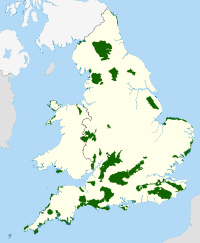Cornwall Area of Outstanding Natural Beauty
| Cornwall | |
|---|---|
| Area of Outstanding Natural Beauty | |
_edit.jpg) | |
| Country | England |
| County | Cornwall |
| Location | South West England |
| - coordinates | 50°30′32″N 4°35′49″W / 50.509°N 4.597°WCoordinates: 50°30′32″N 4°35′49″W / 50.509°N 4.597°W [1] |
| Highest point | Brown Willy |
| - elevation | 420 m (1,378 ft) |
| Founded | 1959 |
 Location of Cornwall AONB | |
| Website : www.cornwall-aonb.gov.uk | |
The Cornwall Area of Outstanding Natural Beauty covers 958 square kilometres (370 sq mi) in Cornwall, England, UK; that is, about 27% of the total area of the county. It comprises 12 separate areas, designated under the National Parks and Access to the Countryside Act 1949 for special landscape protection. Of the areas, eleven cover stretches of coastline; the twelfth is Bodmin Moor. The areas are together treated as a single Area of Outstanding Natural Beauty (AONB).
Section 85 of the Countryside and Rights of Way Act 2000 places a duty on all relevant authorities when discharging any function affecting land within an AONB to have regard to the purpose of conserving and enhancing natural beauty. Section 89 places a statutory duty on Local Planning Authorities with an AONB within their administrative area to produce a 5-year management plan.
Designation
The areas were designated in 1959, except for the Camel estuary which was added in 1981.[2] The list of designated areas is:[3]
- Hartland (Morwenstow and Kilkhampton)
- Pentire Point to Widemouth
- Camel Estuary
- Trevose Head to Stepper Point (Bedruthan to Padstow)
- St Agnes
- Godrevy to Portreath
- West Penwith
- South Coast - Western (Lizard and Marazion to Helford River)
- South Coast - Central (Mylor & the Roseland to Porthpean)
- South Coast - Eastern (Par Sands to Looe)
- Rame Head
- Bodmin Moor
There are separate AONBs covering the Isles of Scilly and the Tamar Valley (which is partly in Cornwall).
Management
The Cornwall AONB is managed by a Partnership of 21 organisations
- Cornwall Agri-food Council
- Cornwall Association of Local Councils
- Cornwall Council
- Cornwall Heritage Trust
- Cornwall Rural Community Charity
- Cornwall Sustainable Tourism Project (CoaST)
- Cornwall Wildlife Trust
- Country Land and Business Association
- ERCCIS
- Historic England
- Farming & Wildlife Advisory Group (FWAG)
- King Harry Ferry
- National Farmers Union
- National Trust
- Natural England
- Rural Cornwall & Isles of Scilly Partnership (RCP)
- University of Exeter in Cornwall
- VisitCornwall
- Volunteer Cornwall
- West Country Rivers Trust
The Partnership meets twice a year to identify the prioritisation of action and the implementation of the Plan. The Partnership also has an advisory role, providing advice to Cornwall Council and other organisations on matters such as planning and project development. The Partnership is supported by a team of officers – the Cornwall AONB Unit who exist to administer the Partnership, undertake delivery, access resources, influence, enable and support Partner organisations in the delivery of the Management Plan.
The first Cornwall AONB Management Plan was adopted by the members of the Cornwall AONB Partnership [4] in July 2004. The latest Cornwall AONB Management Plan was adopted by Cornwall Council and the members of the Cornwall AONB Partnership [4] in February 2011.[5]
References
- ↑ "Cornwall Area of Outstanding Natural Beauty". protectedplanet.net.
- ↑ Cornwall AONB Archived August 29, 2013, at the Wayback Machine.. Accessed 20 April 2012
- ↑ Cornwall AONB: Explore. Accessed 21 December 2015
- 1 2 Cornwall AONB Partnership
- ↑ Management Plan 2011-2016
